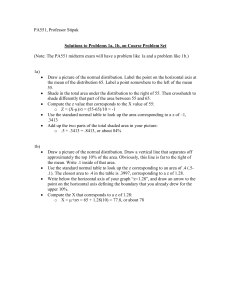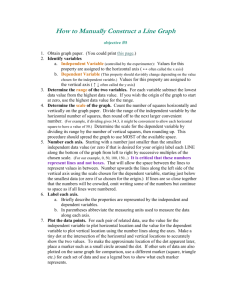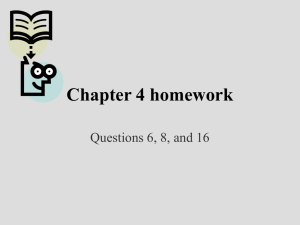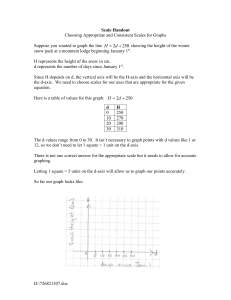Study Questions
advertisement
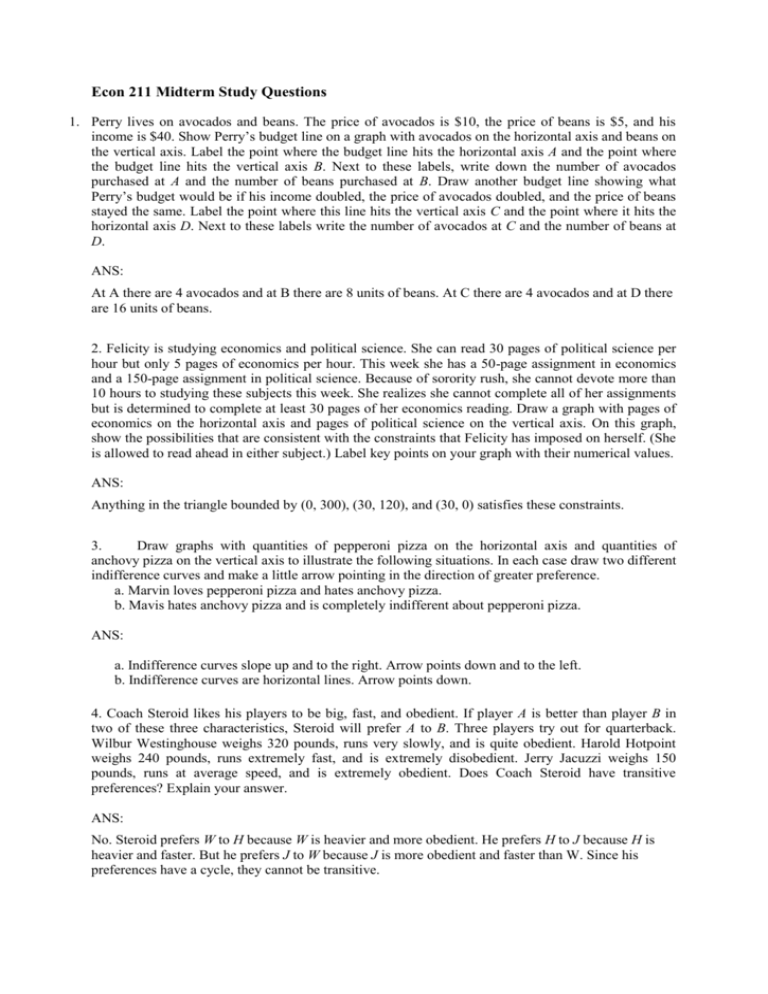
Econ 211 Midterm Study Questions
1. Perry lives on avocados and beans. The price of avocados is $10, the price of beans is $5, and his
income is $40. Show Perry’s budget line on a graph with avocados on the horizontal axis and beans on
the vertical axis. Label the point where the budget line hits the horizontal axis A and the point where
the budget line hits the vertical axis B. Next to these labels, write down the number of avocados
purchased at A and the number of beans purchased at B. Draw another budget line showing what
Perry’s budget would be if his income doubled, the price of avocados doubled, and the price of beans
stayed the same. Label the point where this line hits the vertical axis C and the point where it hits the
horizontal axis D. Next to these labels write the number of avocados at C and the number of beans at
D.
ANS:
At A there are 4 avocados and at B there are 8 units of beans. At C there are 4 avocados and at D there
are 16 units of beans.
2. Felicity is studying economics and political science. She can read 30 pages of political science per
hour but only 5 pages of economics per hour. This week she has a 50-page assignment in economics
and a 150-page assignment in political science. Because of sorority rush, she cannot devote more than
10 hours to studying these subjects this week. She realizes she cannot complete all of her assignments
but is determined to complete at least 30 pages of her economics reading. Draw a graph with pages of
economics on the horizontal axis and pages of political science on the vertical axis. On this graph,
show the possibilities that are consistent with the constraints that Felicity has imposed on herself. (She
is allowed to read ahead in either subject.) Label key points on your graph with their numerical values.
ANS:
Anything in the triangle bounded by (0, 300), (30, 120), and (30, 0) satisfies these constraints.
3.
Draw graphs with quantities of pepperoni pizza on the horizontal axis and quantities of
anchovy pizza on the vertical axis to illustrate the following situations. In each case draw two different
indifference curves and make a little arrow pointing in the direction of greater preference.
a. Marvin loves pepperoni pizza and hates anchovy pizza.
b. Mavis hates anchovy pizza and is completely indifferent about pepperoni pizza.
ANS:
a. Indifference curves slope up and to the right. Arrow points down and to the left.
b. Indifference curves are horizontal lines. Arrow points down.
4. Coach Steroid likes his players to be big, fast, and obedient. If player A is better than player B in
two of these three characteristics, Steroid will prefer A to B. Three players try out for quarterback.
Wilbur Westinghouse weighs 320 pounds, runs very slowly, and is quite obedient. Harold Hotpoint
weighs 240 pounds, runs extremely fast, and is extremely disobedient. Jerry Jacuzzi weighs 150
pounds, runs at average speed, and is extremely obedient. Does Coach Steroid have transitive
preferences? Explain your answer.
ANS:
No. Steroid prefers W to H because W is heavier and more obedient. He prefers H to J because H is
heavier and faster. But he prefers J to W because J is more obedient and faster than W. Since his
preferences have a cycle, they cannot be transitive.
5. Belinda loves chocolate and always thinks that more is better than less. Belinda thinks that a few
piano lessons would be worse than none at all, but if she had enough piano lessons to get good at
playing the piano, she would prefer more lessons to less. Draw a graph with piano lessons on the
horizontal axis and chocolate on the vertical axis. On your graph sketch two indifference curves for
Belinda that would be consistent with this story. Label the better of the two indifference curves AA and
the worse one BB.
ANS:
The indifference curves would look something like inverted U’s. (The area under these curves needn’t
be necessarily convex.) The better of the two curves drawn is the higher one.
6.
If good X is measured on the horizontal axis and good Y on the vertical, what can you say
about the preferences of someone whose indifference curves are
a. parallel to the Y axis?
b. positively sloped with more desirable indifference curves as one moves to the right?
c. negatively sloped with more desirable indifference curves as one moves to the left?
ANS:
a. This person doesn’t care how much Y he has.
b. This person likes X but hates Y.
c. This person hates both goods.
7. Use separate graphs to sketch two indifference curves for people with each of the following utility
functions:
a. U(x, y) = x + 2y.
b. U(x, y) = min{x,2y}.
c. U(x, y) = max{x,2y}.
ANS:
a. These are straight lines with slope
.
b. These are L-shaped. The corners lie along the locus x = 2y.
c. A typical indifference curve consists of a horizontal line from the y axis to the locus x = 2y and then
a vertical line to the y axis from the point where the horizontal line met the line x = 2y.
8. Max has the utility function U(x, y) = x(y + 1). The price of x is $2 and the price of y is $1. Income
is $10. How much x does Max demand? How much y? If his income doubles and prices stay
unchanged, will Max’s demand for both goods double?
ANS:
To set his MRS equal to the price ratio, Max sets
. His budget constraint is 2x + y = 10.
Solve these two equations to find that
and
. If his income doubles and prices stay
unchanged, his demand for both goods does not double. A quick way to see this is to note that if
quantities of both goods doubled, the MRS would not stay the same and hence would not equal the
price ratio, which has stayed constant.
9. Max has a utility function U(x, y) = 2xy + 1. The prices of x and y are both $1 and Max has an
income of $20.
a. How much of each good will he demand?
b. A tax is placed on x so that x now costs Max $2 while his income and the price of y stay the same.
How much of good x does he now demand?
c. Would Max be as well off as he was before the tax if when the tax was imposed, his income rose by
an amount equal to $1 times the answer to part (b)?
ANS:
a. 10x and 10y.
b. 5x.
c. No.
10. Martha has the utility function U = min{ 4x, 2y}. Write down her demand function for x as a
function of the variables m, px, and py, where m is income, px is the price of x, and py is the price of y.
ANS:
.
11. With some services, e.g., checking accounts, phone service, or pay TV, a consumer is offered a
choice of two or more payment plans. One can either pay a high entry fee and get a low price per unit
of service or pay a low entry fee and a high price per unit of service. Suppose you have an income of
$100. There are two plans. Plan A has an entry fee of $20 with a price of $2 per unit. Plan B has an
entry fee of $40 with a price of $1 per unit for using the service. Let x be expenditure on other goods
and y be consumption of the service.
a. Write down the budget equation that you would have after you paid the entry fee for each of the two
plans.
b. If your utility function is xy, how much y would you choose in each case?
c. Which plan would you prefer? Explain.
ANS:
a.x + 2y = 80, x + y = 60.
b. 20, 30.
c. Plan B. The utility of the bundle chosen with Plan A is 20(40) = 800 and the utility from the Plan B
bundle is 30(30) = 900.
